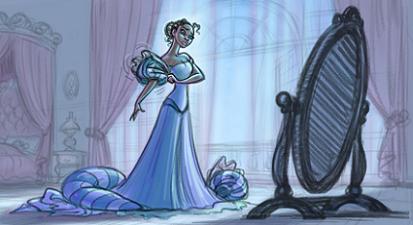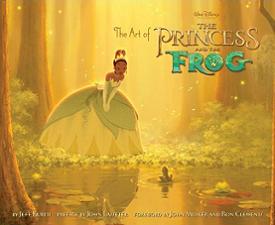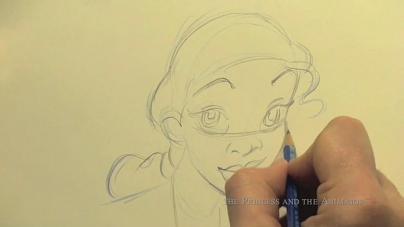Jeremie Noyer concludes his five-part discussion with Mark Henn in celebration of the worldwide launch of The Princess And The Frog from the US release to its European debut, and evoking the chronology and different aspects of the veteran animator’s career, from his studies and dreams of working for Disney, to his first assignments and serving as supervising animator on the Studio’s current contemporary classic!
From “Disney dreams” of working at Disney Animation and landing his first assignments working on such classics as The Fox And The Hound, Mickey’s Christmas Carol, The Great Mouse Detective, The Lion King and Lilo And Stitch to becoming the “go-to” guy for animating the Studio’s long line of feisty females, including Ariel, Belle, Jasmine, Pocahontas and Mulan, and seeing the changing fortunes of his craft through involvement in John Henry, Home On The Range and Meet The Robinsons, Mark Henn as been one of those at the forefront of the resurgence in popularity of Disney’s animated films.
So who better to be asked to animate the heroine of the Studio’s return to traditionally animated storytelling than this legendary artist? In the climax of our five-part series of interviews, Mark talks about his latest creation, Tiana, for Disney’s current theatrical release The Princess And The Frog, which begins its European roll-out this weekend in the UK.
Animated Views: For Princess and the Frog, you animated three characters in one, as you animated adult Tiana, young Tiana and frog Tiana. Can you tell me about that challenge?
Mark Henn: It certainly was a challenge. It’s something very unique to Princess Tiana. So, we had to come up with three different designs which is a little extra work, but the other important thing was making sure that, when she’s a frog, she is the same character. Even though she looks different, she’s still Tiana, but she just looks like a frog, now. So, those were different challenges on the film.
AV: You animated Ariel, who is both a mermaid and a human, and Mulan, who is a girl, but at some point stands as a male soldier. In what way did that experience help you deal with the different aspects of one character on Tiana?
MH: Certainly, having gone through those films and those characters, it helped me to think back to how I worked with those different solutions. But each of those are slightly different. It was just a matter of sitting down and trying to find a design. We started with the human Tiana – what would she look like as a little girl of about 5 to 7 years old? Then, of course, what she’s gonna look like as a frog – and she had to be a very appealing frog. She could be a lovely frog, but she needed to be very attractive. So, it was just a matter of diving in and working hard to come up with designs that the directors like, then going ahead animating those things.

AV: Can you tell me about the “design” part of your work on Tiana?
MH: One of the things that we did is that the whole group of the supervising animators and the directors and a couple of the visual development artists, we spent a weekend. We ran away for a weekend to a hotel resort. Our whole time was going over all of the characters of the movie and everybody got to pitch in and put forward their ideas. We spent maybe a morning working on Tiana, and then the afternoon working on Prince Naveen, and all the different characters. That was one of the real important steps. The rest of the time, we would just be taking the results of that week end, and for myself, just spending a lot of time making drawing and showing them to the directors and they would say they like this one or they didn’t like that one, and drawing up the things they didn’t like and build on the elements of the designs that they did like and then start animating some tests. We had Anika’s voice early on in the production, so I was able then to take some tracks of hers and animate some test scenes to see if the design and the voice were matching up well for the character.
AV: You can’t go wild with leading ladies like Tiana. Did her frog aspect allow you to have more fun with her animation?
MH: Yes, it did. Certainly, that was one fun aspect in animating Tiana because, as a leading lady, as a human character, fairly naturalistically handled, you can’t over-animate that type of a character. But with Tiana as a frog, you can be a lot broader and have a lot more fun with the animation in that sense. And even as a little girl. She could be a little broader because she was a child. And I thought that was an opportunity there to do something with it. But there were some ways to make sure that Tiana as a human character is very interesting and fun to animate as well.
AV: How did you work with Randy Haycock on the scenes involving both Tiana and Prince Naveen, who is a very different character?
MH: It just depends on the scene. Usually, what happens is: one of the characters that’s kind of the dominant character in the scene. So, one of us would usually animate our character first, and then we would hand it to the other animator, and then we would add our part in. So, it’s just kind of a simple back-and-forth that way. I might start a scene, animate Tiana and kind of roughly indicate where I think Prince Naveen should be standing, and then Randy would come in and he would add Prince Naveen. Now, if he played the hand at a certain point, I could go back and make adjustments. So, we kind of just worked back-and-forth that way. Or vice-versa, he may be animating a scene with Prince Naveen first and then I would add Tiana in and again, we’d just work back-and-forth that way.
AV: Tiana in some way is kind of “practically perfect” whereas Prince Naveen obviously has some flaws. How did you and Randy Haycock find the right balance in both your ways of acting?
MH: That’s interesting that you put it that way with Tiana. She is perfect to a fault, let’s put it that way. She is very disciplined, more so that Prince Naveen, but to the point where she is so focused on her dream and her goals that she kind of pushes the rest of her life aside. So, she doesn’t enjoy life as much as Prince Naveen. And those are the kind of the elements that each of them bring to each other in their relationship. Prince Naveen probably needs a little more discipline in his like, and Tiana needs to learn from Prince Naveen how to enjoy life a little more. And through that process, of course, they both find love, which is very critical to the theme of the movie. That’s the one thing that Tiana had forgotten, the thing that her dad had tried to tell her as a little girl never to forget. And that’s the thing that she did forget and had to re-learn. She re-learns that through the journey with Naveen.
AV: Some artists who worked on Princess and the Frog went to Disney’s Animation Research Library to research the look of classic Walt Disney films such as Lady and the Tramp. Did you do that same as the animator of Tiana?
MH: Not real thorough. John Lasseter told us early in the production that his vision or his idea for the film was that it would be very much in the kind of the Golden Age, if you will, of the films from the 40s and 50s, the Peter Pan, the Lady and the Tramp, which was, in his mind, kind of the classic Disney look, with characters that were well designed, kind of nice, dimensionally drawn characters, fully animated. So, we did study Lady and the Tramp for various reasons. But from the animation point of view, it was the idea of looking at well designed, very dimensionally designed characters that were fully animated in the Disney style, which we’ve always wanted to do and have been doing since I started here. But that was kind of the mandate that we got from John Lasseter, kind of what he was thinking about how to approach this film.
AV: What do you mean by the “Disney style”?
MH: The Disney style is what John had in his mind, that he saw with the film. That is fully animated – that’s not a limited style of animation, everything that needs to move is moving. But there’s also very complete personalities, very identifiable. The layout and background paintings are very rich. Balance between realistic and yet an artistic kind of impression of things. That’s one of the reasons why we looked at Lady and the Tramp, because it has a lot of those elements. There’s a simplicity to the film, and yet there’s a great balance between that simplicity and detail in the background as well as the animated characters.
AV: What part of Tiana’s personality do you feel the most connected to?
MH: I think, with Tiana, one of the things that I really enjoyed with her was her sense of humor. I can certainly identify with her discipline, her goal-setting and having a dream, I can clearly identify with that. But I also really appreciated her sense of humor which rises more throughout the film, as she becomes a little more comfortable and, as they say it here, when she lets her hair down and relaxes a little bit, she becomes a pretty funny character.
AV: Music is very important in that movie. How did you approach the songs?
MH: You approach a song sequence just like you would approach any other sequence in particular. I didn’t work on the Almost There sequence which is kind of the fantasy sequence. Eric Goldberg took that over because he has a real taste for music and animating to music, but I did the lead up to the beginning of the song, and then I finished the song, as well as worked on the songs in the end and at the very beginning of the movie. But you really approach it not too differently from the rest of your animation. You wanna be aware of the timing and the beat, and you wanna make sure that the movements are hitting beats, rhythmically moving with music, as opposed to fighting against that.

AV: As a designer and supervising animator, you brought a lot to Tiana. But what did you learn from her?
MH: That’s a good question. Well, I did learn to balance my life like she needed to balance hers. I had to make sure I was disciplined and had my goals in mind. But I also had to make sure I enjoyed my life once I got home, for the few hours that I had, particularly in the last six months when we were really working very hard to get the movie finished. That was that kind of balance learns herself. She was out of balance and had learn that, and I needed to make sure that I balanced between my work and enjoying my life home with my family.
AV: After having supervised Lewis in Meet the Robinsons, how was it to get back to hand-drawn, traditional animation?
MH: Well, I have to be honest. I did not enjoy animating on the computer as much as I enjoy drawing. It’s what I had done for over twenty years when I learned the computer. There’s still that excitement of seeing your scene come to life as a computer animated film, but the process is not as interesting or satisfying to me as an artist. I really enjoy drawing. So, when they announced that we were going to go back and make 2D films again, I and most of the 2D animators around here were very, very happy, and happy to be drawing again. To me, it’s like breathing. It’s a very natural thing for me to do and much more personally satisfying than moving a mouse around on a computer.
AV: You met John Lasseter at Cal Arts. How was it to meet him again now at the command at Disney?
MH: I knew John a little bit at Cal Arts and then our paths crossed. I recognized at that time – and this is the truth – as I got to know him, I could have probably told you back then that John Lasseter was destined for something very unique, and occupy a very unique place in our industry. What that was, I couldn’t probably tell you but you recognized he was very gifted and had a particular gift for storytelling. I just knew that he was gonna have a very special career because of that.
AV: What did you enjoy the most in the production of Princess and the Frog?
MH: Just the fact that we got to do it, the fact that after almost five years of having the Studio say “we’re not gonna make animated 2D, hand-drawn films anymore”, the fact that we got to make a new hand-drawn movie, I think that’s probably the biggest memory, and fun memory that we had that challenge, we had to kind of learn all over again what that process was from a studio’s point of view. But for me as an artist, to be able to go back and flipping and drawing on paper and animating on paper was the greatest memory.
AV: What was the most rewarding scene you got to work on?
MH: What come to mind first is the sequence when she’s at the window as a little girl and she’s wishing on the star for the first time. I think that little sequence was very nice. But I also like its adult equivalent when she’s out on the balcony of the house and she’s at rock bottom in her life and she finishes the song and wishes on a star again and of course then meets Prince Naveen as a frog, and then going into that little sequence where he’s introducing himself as a prince and she hits him on the head with the book and all that. I also enjoy sequences of her as a frog when she and Naveen have their little verbal banters back and forth. Those were fun sequences to animate.
AV: You spoke about the joy of animating in 2D. Will you be part of the upcoming Winnie the Pooh feature?
MH: Yes, I am. I’m gonna be the supervising animator for Winnie the Pooh!
is available to order now from Amazon.com




